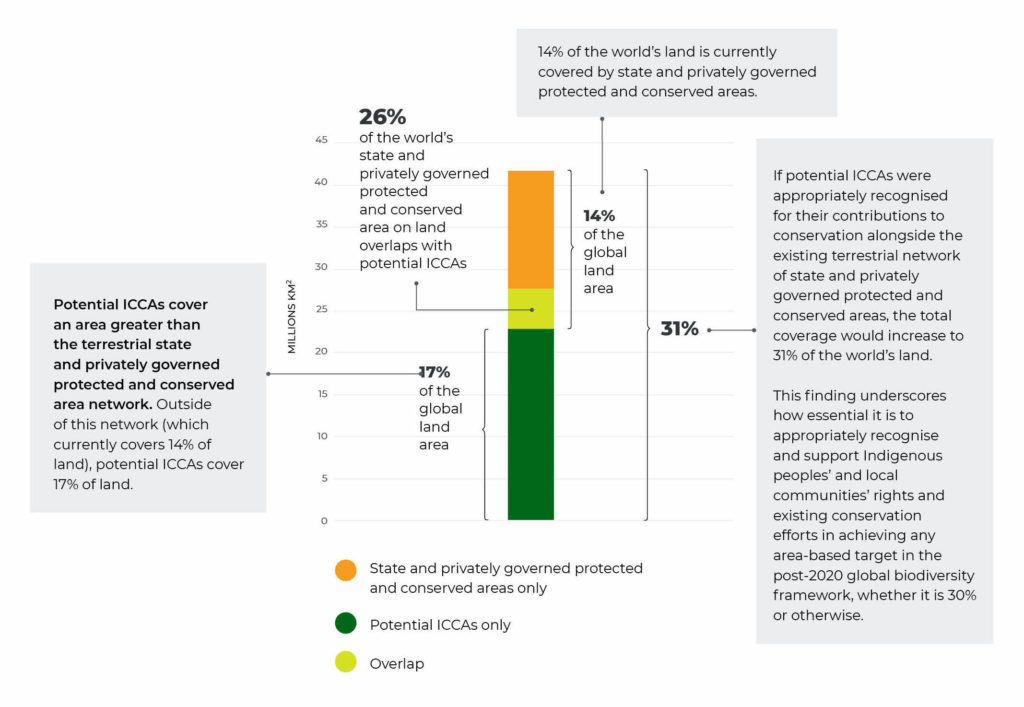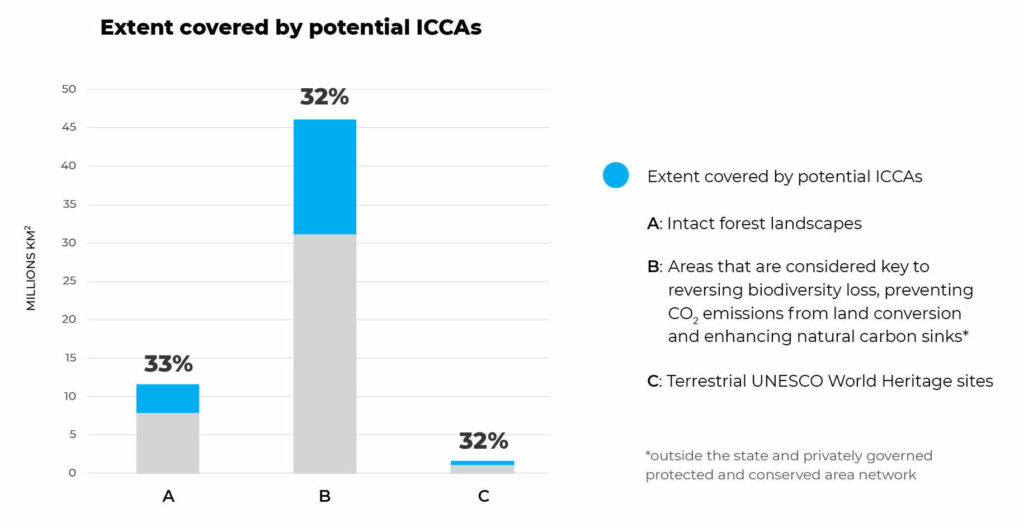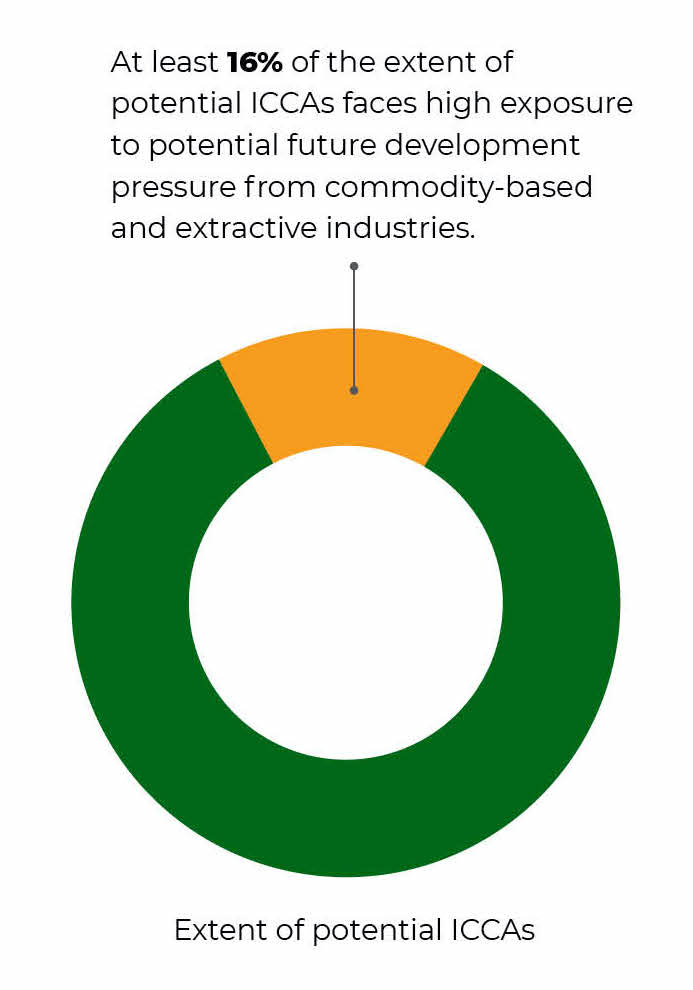- Home
- Executive summary
- Territories
- Kisimbosa – DR Congo
- Yogbouo – Guinea
- Fokonolona of Tsiafajavona – Madagascar
- Kawawana – Senegal
- Lake Natron – Tanzania
- Qikiqtaaluk – Canada
- Sarayaku – Ecuador
- Komon Juyub – Guatemala
- Iña Wampisti Nunke – Peru
- Hkolo Tamutaku K’rer – Burma/Myanmar
- Fengshui forests of Qunan – China
- Adawal ki Devbani – India
- Tana’ ulen – Indonesia
- Chahdegal – Iran
- Tsum Valley – Nepal
- Pangasananan – Philippines
- Homórdkarácsonyfalva Közbirtokosság – Romania
- National and regional analyses
- Global analysis
Summary of the global spatial analysis
We have reached a critical juncture in shared human history. We have seen all too clearly since the rise of the COVID-19 pandemic how people and nature are interdependent, how our health and wellbeing are intimately connected with that of the rest of the planet and how the climate, biodiversity and social crises are deeply interlinked. There is growing global consensus around one of the best opportunities to turn the tide and ensure that our species and the billions of others with whom we share the planet continue to co-exist and thrive well into the future. It includes listening to, respecting and appropriately recognising and supporting Indigenous peoples and local communities whose cultures and governance systems have shaped and nurtured the diversity of life on Earth for generations and millennia, and who continue to do so today even in the face of significant threats. From local to global levels, all actors and duty-bearers in the conservation sector should prioritise strengthening the deep connections between cultural and biological diversity, while respecting, protecting and fulfilling the rights of Indigenous peoples and local communities.
This global analysis is the first of its kind to analyse the estimated extent and conservation values of territories and areas conserved by Indigenous peoples and local communities (abbreviated as ICCAs—territories of life). It builds upon a companion report produced over a similar timeframe (WWF et al., 2021, forthcoming) that assessed Indigenous peoples’ and local communities’ lands more broadly; it refines the dataset created in that report to focus specifically on the estimated extent of ICCAs—territories of life. The analysis provides technical and scientific evidence to strengthen key aspects of the post-2020 global biodiversity framework and its implementation. It illustrates that fulfilling the Convention on Biological Diversity’s proposed 2050 vision of “living in harmony with nature” can only be achieved through a human rights-based approach that respects Indigenous peoples and local communities as rights-holders and holds governments, conservation organisations and private actors accountable as duty-bearers.
Key Findings
- Indigenous peoples and local communities play an outsized role in the governance, conservation and sustainable use of the world’s lands and biodiversity. It is estimated that potential ICCAs cover more than one-fifth (21%) of the world’s land (approximately the size of Africa), and over one-fifth (22%) of the extent of the world’s terrestrial Key Biodiversity Areas. As custodians of such a large proportion of the world, they must be acknowledged and respected as rights-holders, protagonists and leaders in relevant decision-making processes, and their rights to self-determination and collective lands and territories recognised and upheld so they can protect themselves from threats.

- At least one-quarter (26%) of the world’s state and privately governed protected and conserved area on land overlaps with potential ICCAs. Therefore, Indigenous peoples and local communities are likely the de facto custodians of many existing protected and conserved areas, without being formally recognised as such. In many cases, it is precisely because of Indigenous peoples’ and local communities’ actions and contributions to biodiversity that these sites have been deemed ‘suitable’ for formal protection. This overlap also raises significant concerns with both the historical and continuing human rights implications of protected and conserved areas for Indigenous peoples and local communities, including potential forced displacement, undermining of customary and local governance and management systems and criminalisation of cultural practices.
- Almost one-third (31%) of the world’s land may already be covered by areas that are dedicated to conservation and/or maintaining the land in good ecological condition. If potential ICCAs were recognised for their contributions to conservation alongside the existing state and privately governed protected and conserved area network (14% of the world’s land), the total coverage would increase to 31%. This finding underscores how essential it is to appropriately recognise and support Indigenous peoples’ and local communities’ rights and existing conservation efforts in achieving any area-based target in the post-2020 global biodiversity framework, whether it is 30% or otherwise. Indigenous peoples and local communities and civil society organisations have expressed serious concerns with the current draft’s Target 2. This analysis illustrates both the opportunity and need to explicitly incorporate human rights, governance diversity and equity into the target, and ensure that its implementation respects Indigenous peoples and local communities as rights-holders.
- Potential ICCAs cover an area greater than the terrestrial state and privately governed protected and conserved area network. Outside of this network (which currently covers 14% of land), potential ICCAs cover 17% of land. In many cases, Indigenous peoples and local communities govern and manage their territories and lands in ways that are consistent with the definition of a protected or conserved area. However, it is up to the custodians as to whether, and in what ways, they choose to engage with the ‘official’ protected and conserved areas system, and related designations and forms of identification and reporting.

- Potential ICCAs cover at least one-third (33%) of intact forest landscapes globally. They also cover at least one-third (32%) of areas that are considered key to reversing biodiversity loss, preventing CO2 emissions from land conversion and enhancing natural carbon sinks. This finding indicates that in addition to being rights-holders to these territories and areas, Indigenous peoples and local communities are also the protagonists and agents of change in local-to-global efforts to protect forest landscapes, halt further biodiversity loss, reduce wildfires and mitigate climate breakdown.
- Some areas governed by Indigenous peoples and local communities are recognised by UNESCO as natural sites of outstanding universal value. Almost one-third (32%) of the extent of UNESCO’s Natural and Mixed World Heritage sites on land overlaps to some extent with potential ICCAs. This role should be acknowledged and supported, with subsequent conservation efforts aiming to reinforce and support the deep connections between cultural and biological diversity in Indigenous peoples’ and local communities’ lands and territories and the social, cultural and spiritual practices that nurture and sustain them.

- At least 16% of the extent of potential ICCAs faces high exposure to future development pressure from commodity-based and extractive industries. Although these high industrial pressures are not inevitable, it is important to be prepared for this possibility, including proactively and urgently supporting Indigenous peoples and local communities to secure their rights to their collective lands and territories and governance systems. This 16% includes areas under high pressure, but the other 84% of the extent should not be considered free from development pressure. Given the significant linkages between potential ICCAs and areas of crucial importance for biodiversity and a healthy climate, supporting Indigenous peoples and local communities to secure their rights and protect and defend their territories and areas against industrial pressures should also be a priority for all actors in the conservation sector.
